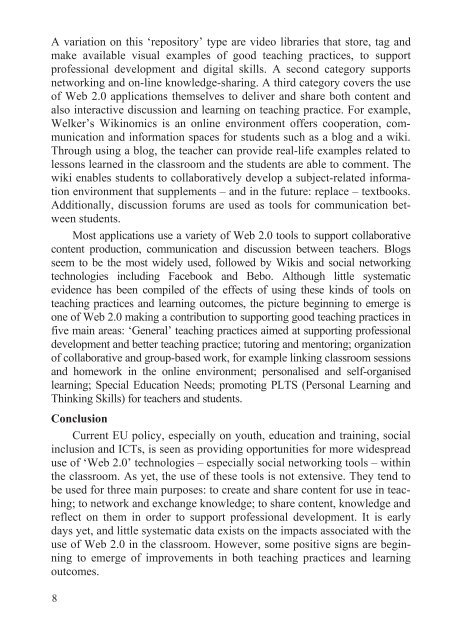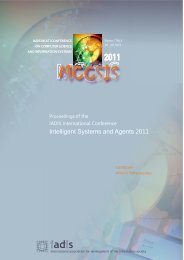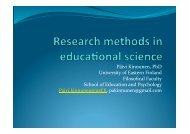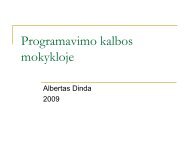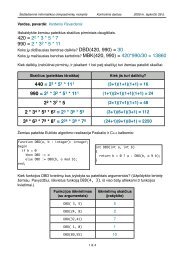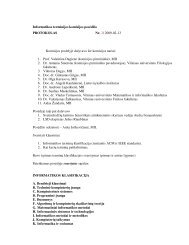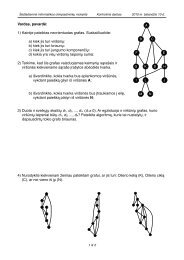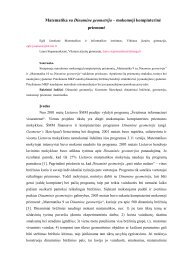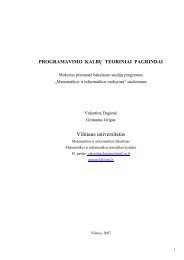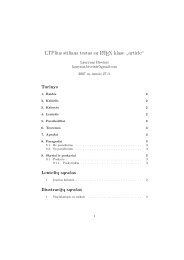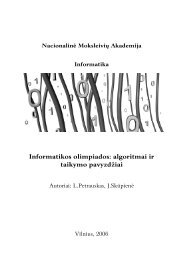innovation - Informatikos metodologijos skyrius - Matematikos ir ...
innovation - Informatikos metodologijos skyrius - Matematikos ir ...
innovation - Informatikos metodologijos skyrius - Matematikos ir ...
Create successful ePaper yourself
Turn your PDF publications into a flip-book with our unique Google optimized e-Paper software.
A variation on this ‘repository’ type are video libraries that store, tag and<br />
make available visual examples of good teaching practices, to support<br />
professional development and digital skills. A second category supports<br />
networking and on-line knowledge-sharing. A th<strong>ir</strong>d category covers the use<br />
of Web 2.0 applications themselves to deliver and share both content and<br />
also interactive discussion and learning on teaching practice. For example,<br />
Welker’s Wikinomics is an online env<strong>ir</strong>onment offers cooperation, communication<br />
and information spaces for students such as a blog and a wiki.<br />
Through using a blog, the teacher can provide real-life examples related to<br />
lessons learned in the classroom and the students are able to comment. The<br />
wiki enables students to collaboratively develop a subject-related information<br />
env<strong>ir</strong>onment that supplements – and in the future: replace – textbooks.<br />
Additionally, discussion forums are used as tools for communication between<br />
students.<br />
Most applications use a variety of Web 2.0 tools to support collaborative<br />
content production, communication and discussion between teachers. Blogs<br />
seem to be the most widely used, followed by Wikis and social networking<br />
technologies including Facebook and Bebo. Although little systematic<br />
evidence has been compiled of the effects of using these kinds of tools on<br />
teaching practices and learning outcomes, the picture beginning to emerge is<br />
one of Web 2.0 making a contribution to supporting good teaching practices in<br />
five main areas: ‘General’ teaching practices aimed at supporting professional<br />
development and better teaching practice; tutoring and mentoring; organization<br />
of collaborative and group-based work, for example linking classroom sessions<br />
and homework in the online env<strong>ir</strong>onment; personalised and self-organised<br />
learning; Special Education Needs; promoting PLTS (Personal Learning and<br />
Thinking Skills) for teachers and students.<br />
Conclusion<br />
Current EU policy, especially on youth, education and training, social<br />
inclusion and ICTs, is seen as providing opportunities for more widespread<br />
use of ‘Web 2.0’ technologies – especially social networking tools – within<br />
the classroom. As yet, the use of these tools is not extensive. They tend to<br />
be used for three main purposes: to create and share content for use in teaching;<br />
to network and exchange knowledge; to share content, knowledge and<br />
reflect on them in order to support professional development. It is early<br />
days yet, and little systematic data exists on the impacts associated with the<br />
use of Web 2.0 in the classroom. However, some positive signs are beginning<br />
to emerge of improvements in both teaching practices and learning<br />
outcomes.<br />
8


